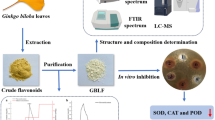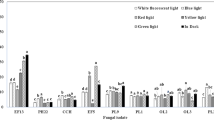Abstract
Selective lignin degrading white rot fungi viz. Phanerochaete chrysosporium, Phlebia brevispora, and Phlebia floridensis were selected to evaluate antioxidant potential and auxin (indole acetic acid) production in complex and synthetic medium. Antioxidant potential of these fungi was tested against different free radicals including 2, 2-diphenyl-1-picrylhydrazyl (DPPH), nitric oxide, ferrous ion, and ferric ion along with total phenolic content. All the fungal strains produce phenolics ranging from 5.2 to 16.7 mg/ml and demonstrated various free radical and metal ion scavenging activity. Growth medium significantly affected all the activities. Almost similar antioxidant activity (~ 72% DPPH scavenging activity) was demonstrated by all the fungi in yeast extract glucose medium; however, the activity was lower in Czapek dox’s medium (from 60 to 45%). Indole acetic acid production was maximum in P. brevispora (31 μg/ml), which was closely followed by P. chrysosporium and P. floridensis. The extracts did not show any mutagenic or cytotoxic effect. Thus, these white rot fungi highlight their significance as a new source for the prompt production of extracellular antioxidants and auxin.


Similar content being viewed by others
References
Birben, E., Sahiner, U. M., Sackesen, C., Erzurum, S., & Kalayci, O. (2012). Oxidative stress and antioxidant defense. World Allergy Organization Journal, 5(1), 9–19.
Bhattacharya, S. (2015). Reactive oxygen species and cellular defense system. In V. Rani & U. C. S. Yadav (Eds.), Free radicals in human health and disease (pp. 17–29). New Delhi: Springer.
Fu, S. F., Wei, J. Y., Chen, H. W., Liu, Y. Y., Lu, H. Y., & Chou, J. Y. (2015). Indole-3-acetic acid: A widespread physiological code in interactions of fungi with other organisms. Plant Signaling & Behavior, 10(8), e1048052.
Kaya, C., Ashraf, M., Dikilitas, M., & Tuna, A. L. (2013). Alleviation of salt stress-induced adverse effects on maize plants by exogenous application of indoleacetic acid (IAA) and inorganic nutrients—a field trial. Australian Journal of Crop Science, 7, 249–254.
Hasanah, Y., Mawarni, L., & Irmansyah, T. (2017). The foliar application of exogenous antioxidant for increasing drought tolerance in soybean. International Journal of ChemTech Research, 10, 156–162.
Basra, S. M., & Lovatt, C. J. (2016). Exogenous applications of moringa leaf extract and cytokinins improve plant growth, yield, and fruit quality of cherry tomato. HortTechnology, 26, 327–337.
Sakata, T., Oshino, T., Miura, S., Tomabechi, M., Tsunaga, Y., Higashitani, N., Miyazawa, Y., Takahashi, H., Watanabe, M., & Higashitani, A. (2010). Auxins reverse plant male sterility caused by high temperatures. Proceedings of the National Academy of Sciences of the United States of America, 107(19), 8569–8574.
Freitas, F., Roca, C., & Reis, M. A. (2015). Fungi as sources of polysaccharides for pharmaceutical and biomedical applications. In V. K. Thakur & M. K. Thakur (Eds.), Handbook of polymers for pharmaceutical technologies: biodegradable polymers (Vol. 3, pp. 61–103). Hoboken: John Wiley & Sons.
Jaszek, M., Kos, K., Matuszewska, A., Grąz, M., Stefaniuk, D., Osińska-Jaroszuk, M., Prendecka, M., Jóźwik, E., & Grzywnowicz, K. (2014). Effective stimulation of the biotechnological potential of the medicinal white rot fungus: Phellinus pini by menadione-mediated oxidative stress. Applied Biochemistry and Biotechnology, 174(2), 644–656.
Jayakumar, T., Thomas, P. A., & Geraldine, P. (2009). In-vitro antioxidant activities of an ethanolic extract of the oyster mushroom, Pleurotus ostreatus. Innovative Food Science & Emerging Technologies, 10(2), 228–234.
Wong, J. Y., & Chye, F. Y. (2009). Antioxidant properties of selected tropical wild edible mushrooms. Journal of Food Composition and Analysis, 22(4), 269–277.
Arora, D. S., Sharma, R. K., & Chandra, P. (2011). Biodelignification of wheat straw and its effect on in vitro digestibility and antioxidant properties. International Biodeterioration and Biodegradation, 65(2), 352–358.
Arora, D. S., & Chandra, P. (2011). In vitro antioxidant potential of some soil fungi: Screening of functional compounds and their purification from Penicillium citrinum. Applied Biochemistry and Biotechnology, 165(2), 639–651.
Arora, D. S., & Sharma, R. K. (2011). Effect of different supplements on bioprocessing of wheat straw by Phlebia brevispora: changes in its chemical composition, in vitro digestibility and nutritional properties. Bioresource Technology, 102(17), 8085–8091.
Subrahmanyam, G., Sharma, R. K., Kumar, G. N., & Archana, G. (2018). Vigna radiata Var. GM4 plant growth enhancement and root colonization by a multi-metal-resistant plant growth- promoting bacterium Enterobacter sp. C1D in Cr(VI)-amended soils. Pedosphere, 28(1), 144–156.
Maron, D., & Ames, B. (1983). Revised methods for the Salmonella mutagenicity test. Mutation Research, 113(3-4), 173–215.
Chen, X. E., Fang, X. B., & Xia, W. S. (2008). Strain improvement and optimization of the media composition of chitosanase-producing fungus Aspergillus sp. CJ 22-326. African Journal of Biotechnology, 7, 2501–2508.
Robbins, R. J. (2003). Phenolic acids in foods: an overview of analytical methodology. Journal of Agricultural and Food Chemistry, 51(10), 2866–2887.
Gąsecka, M., Mleczek, M., Siwulski, M., Niedzielski, P., & Kozak, L. (2015). The effect of selenium on phenolics and flavonoids in selected edible white rot fungi. LWT- Food Science and Technology, 63(1), 726–731.
Liu, L., Xu, P., Zeng, G., Huang, D., Zhao, M., Lai, C., Chen, M., Li, N., Huang, C., Wang, C., & Cheng, M. (2014). Inherent antioxidant activity and high yield production of antioxidants in Phanerochaete chrysosporium. Biochemical Engineering Journal, 90, 245–254.
Chen, H., Yan, M., Zhu, J., & Xu, X. (2011). Enhancement of exo-polysaccharide production and antioxidant activity in submerged cultures of Inonotus obliquus by lignocellulose decomposition. Journal of Industrial Microbiology & Biotechnology, 38(2), 291–298.
Ishige, K., Schubert, D., & Sagara, Y. (2001). Flavonoids protect neuronal cells from oxidant stress by three distinct mechanisms. Free Radical Biology & Medicine, 30(4), 433–446.
Bounatirou, S., Smiti, S., Miguel, M. G., Falerio, L., Rejeb, M. N., Neffati, M., Casto, M. M., Figueiredo, A. C., Barroso, J. G., & Pedro, L. G. (2007). Chemical composition, antioxidant and antibacterial activities of the essential oils isolated from Tunisian Thymus capitatus Hoff et link. Food Chemistry, 105(1), 146–155.
Wang, Y., & Zhou, D. (2017). Effects of white rot fungi on nutritional value and antioxidant property of corn stover. Chinese Journal of Animal Nutrition, 29, 4108–4115.
Dey, T. B., Chakraborty, S., Jain, K. K., Sharma, A., & Kuhad, R. C. (2016). Antioxidant phenolics and their microbial production by submerged and solid state fermentation process: a review. Trends in Food Science and Technology, 53, 60–74.
Kumar, C. S., Jacob, T. K., Devasahayam, S., Thomas, S., & Geethu, C. (2018). Multifarious plant growth promotion by an entomopathogenic fungus Lecanicillium psalliotae. Microbiological Research, 207, 153–160.
Yurekli, F., Geckil, H., & Topcuoglu, F. (2003). The synthesis of indole-3-acetic acid by the industrially important white-rot fungus Lentinus sajor-caju under different culture conditions. Mycological Research, 107(3), 305–309.
Bose, A., Shah, D., & Keharia, H. (2013). Production of indole-3-acetic-acid (IAA) by the white rot fungus Pleurotus ostreatus under submerged condition of Jatropha seedcake. Mycology, 4(2), 103–111.
Ünyayar, S. (2002). Changes in abscisic acid and indole-3-acetic acid concentrations in Funalia trogii (Berk.) Bondartsev & Singer and Phanerochaete chrysosporium Burds. ME446 subjected to salt stress. Turkish Journal of Botany, 26, 1–4.
Acknowledgements
R. K. Sharma is thankful to Manipal University, Jaipur for providing Enhanced Seed Grant and CFMR, USDA, Madison, Wisconsin for proving the fungal cultures.
Author information
Authors and Affiliations
Corresponding author
Ethics declarations
Conflict of Interest
The authors declare that they have no conflict of interest.
Rights and permissions
About this article
Cite this article
Chandra, P., Arora, D.S., Pal, M. et al. Antioxidant Potential and Extracellular Auxin Production by White Rot Fungi. Appl Biochem Biotechnol 187, 531–539 (2019). https://doi.org/10.1007/s12010-018-2842-z
Received:
Accepted:
Published:
Issue Date:
DOI: https://doi.org/10.1007/s12010-018-2842-z




